RAMALLAH, June 19, 2014 – (WAFA)
– UNRWA Records indicated that the number of registered Palestinian refugees on
the first of January 2014 amounted up to
about 5.4 million, said Thursday the Palestinian Central Bureau of
Statistics (PCBS) in a press release.
UNRWA Records indicated that
these figures represented the minimum number of Palestinian refugees.
Palestinian refugees in West Bank who are registered with UNRWA as in the
beginning of 2014 accounted up to 16.8 % of the total refugees registered with
UNRWA against 24.1% in Gaza Strip. At the level of the Arab countries, the
percentage of Palestinian refugees registered with UNRWA in Jordan, amounted up
to 39.7% of the total Palestinian refugees while the percentage of Palestinian
refugees registered with UNRWA in Lebanon and Syria reached 8.9% and 10.5%
respectively.
66% of Palestinians who were living in
Historic Palestine (British-Mandated Palestine) in 1948 were Expelled and
Displaced
The
human plight and tragedy that has befallen on the Palestinian people in
1948, a devastating tragedy was expelled and displaced from land seized by
Israel as about 957 thousand Palestinian Arabs, representing 66.0 % of the
total Palestinians who were living in historic Palestine on the eve of the war
of 1948, according to UN estimates in 1950.
Several official estimates on the number of
Palestinian refugees on the eve of the 1948 war
was released from various sources, including official British, American,
Palestinian and Israeli estimates as well as the United Nations estimates.
However, United Nations released two estimates: the first referred to the
number of Palestinian refugees that amounted to about 726 thousand refugees as
based on the estimates of the United Nations in 1949. And the second that amounted to 957 thousand
refugees as based on estimates of 1950.
41% of the totals Population in Palestine are
Refugees
Data refer that the percentage of
the population of refugees in Palestine in 2013 is estimated at 41.2% of the
total Palestinian population living in Palestine, and data indicated that 26.1%
of the population in West Bank are refugees, while the percentage of refugees
in Gaza Strip is about 65.3%.
Palestinian Refugees are characterized as a
Youngsters Community
Statistical data of 2013
indicated that the percentage of persons aged less than 15 years in Palestine
reached 39.9% (as of 41.1% for refugees
and 39.1% for non- refugees), while the percentage of elderly aged 60 years and
over among refugee reached 4.2% of the total refugees while for non- refugees reached 4.5%.
Palestinian Refugee Women living
in Palestine are the most Fertility
Statistical data of 2010
indicated that the total fertility rate for the period (2008-2009) in Palestine
amounted to 4.4 births, and the average number of the children ever born
amounted to 4.3 births for 2010. When compared to those rates by refugee
status, it is clear to us that there are light differences between total
fertility rates and the average number of children ever born as the total
fertility rate and the average number of children among refugee reached 4.4
births and 4.3 births respectively, while these rates among non-refugee reached
4.3 and 4.2 births respectively.
Palestinian Refugees are poorer
than non-refugees
Poverty index showed that poverty
rate in Palestine among refugees according to monthly household real
consumption patterns reached 31.2% in 2011, compared to 21.8% for non-refugees
Data indicated that refugee population of
camps in Palestine are poorer compared with rural and urban population. Data of
real monthly consumption patterns showed that 35.4% of the camps in Palestine
are suffering from poverty compared to 19.4% in rural areas and 26.1% in urban
areas. These high rates of poverty in refugee camps may be traced back to high unemployment
rates and large size of households in the camps compared with other households
in urban and rural areas, as well as data indicated that there is high poverty
rate in Gaza Strip as a whole where Gaza Strip has highest rates of poverty,
regardless of locality type, as percentage of poverty among individuals in Gaza
Strip reached 38.8% against 17.8% in West Bank.
Refugees are less participation in economic
activities and more likely to unemployment
The results of the Labor Force
Survey in 2013 showed that the rate of participation in labor force among
refugees aged 15 years and over whom residing in Palestine were less than non- refugees
since the rate reached 42.8% and 44.2% respectively. Also, the rate of female
participation of refugee living in Palestine reached 17.3% against 17.2% for
non- refugees. Data indicated that there
is a clear difference on the level of unemployment among refugees and
non-refugees, as unemployment rate among refugees reached up to 28.3% compared
to 20.1% among non-refugees.
One-third of the Refugees are working as
Specialists and Technicians
In 2013, the profession of
'technicians, specialists, assistant, and clerks' considered as the
most accommodating profession among refugees and non- refugees in Palestine
alike as refugees amounted to 33.1% while the non-refugees reached 23.2%. Also,
legislators and senior management staff represented the lowest percentage for
both of refugees and non-refugees with a variation by 3.2% for refugees and 3.8%
for non-refugees.
Half of Youth didn’t yet start the Transition
from Education to the Labor Market
The results of the transition
youth from education to the labor market survey in 2013 in Palestine indicated
that 15.6% of refugee youth completed their transition to stable jobs in the labor
market compared with 20.1% among non refugee youth, while 3.7% of youth refugee
completed their transition to temporary
jobs or as self-employed compared with 4.6% for non refugee youth, 34.2%
of refugee youth pass in the period of transition compared with 30.2% among non
refugee youth, while 46.5% of refugee youth didn’t yet start the transition
period compared with 45.1% of non-refugee youth.
An Increase in Percentages of Educational
Attainment among Refugees
The percentage of illiteracy
among Palestinian refugees in 2013 in Palestine for individuals aged 15 years
and over reached 3.3%, while among non-refugee reached 4.0 %. As a percentage
of Palestinian refugees aged 15 years and over who obtained a bachelor's degree
or higher reached 12.8 % of the total refugees aged 15 years and over against
11.5 % for non-refugees.
About 60% of the Refugee Households live in an
Apartment
Data of 2013 indicated that 47.3%
of the households of Palestine live in an independent house, the percentage among
non-refugee was 54.2% against 36.9% for refugees, and the percentage of household
living in an apartment reached 50.8% (44.5% non-refugee against 60.2% for
refugee). The percentage of refugee households living in a rented accommodation
reached 10.9% of the total refugee households and 77.8% for refugee households are
living in a private residence.
Difference in Percentage of Information
Technology Tools and Communication between Refugee and Non-Refugee Households
Data on information technology
tools and communication with the households indicated that the percentages
provide a means of information and communication among non-refugee households
differ from percentages of refugee households, while the percentages of
non-refugee households that are available for their fix phone reached 34.5% for
non- refugee households against 36.9% for refugee households. The percentage of non-refugee households that
are available for their a smart phone 24.8% while the percentage of the refugee
households 17.0%, and, the percentage of availability of a computer with
non-refugee households 54.6% while the value of the refugee households 51.9%,
and about the availability of Internet service at home, the percentage of
households refugee 34.7% versus 37.7% for non-refugee households.
K.F./T.R.










